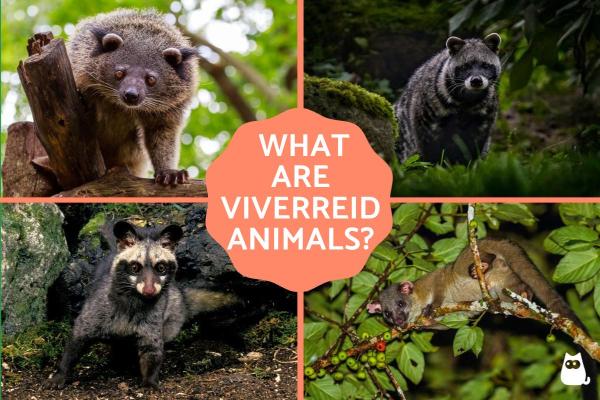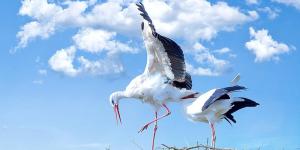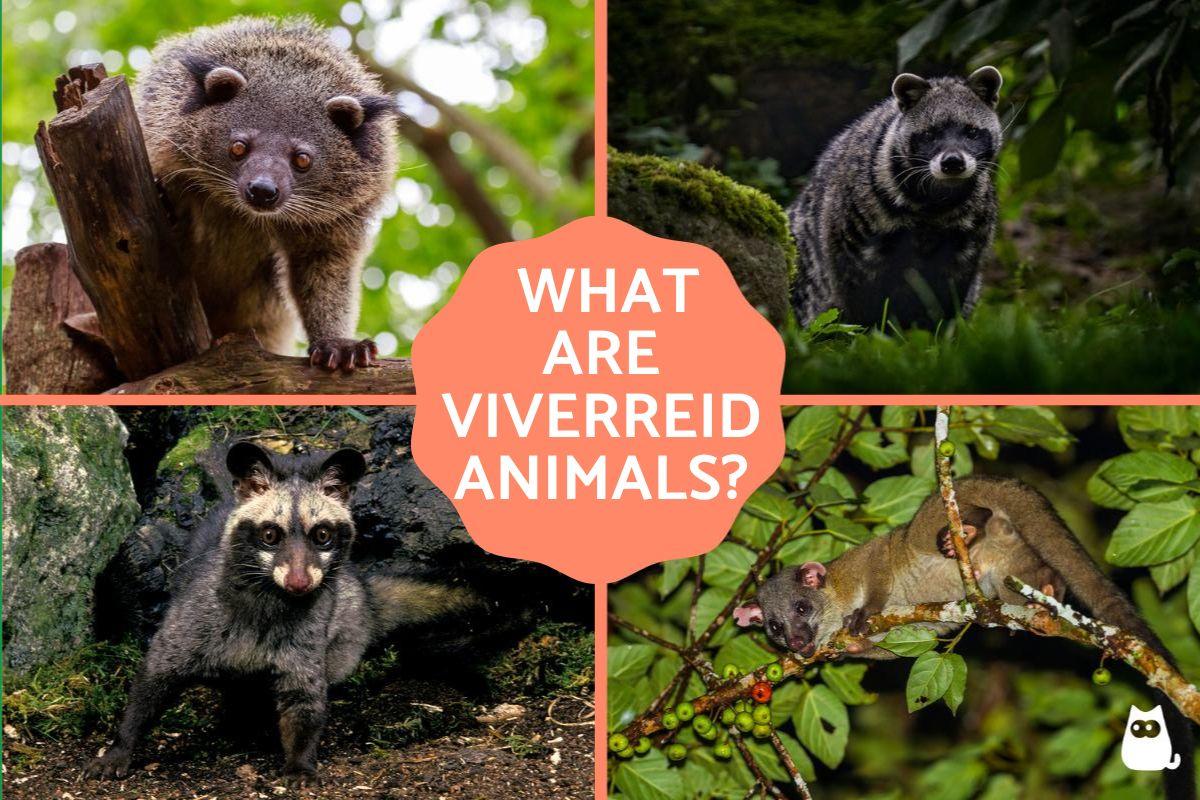What Are Viverrids Animals? - Viverridae Family


Viverrids, also known as civets and genets, are a mysterious and fascinating group of carnivorous mammals. They come in all shapes and sizes, from the tiny African palm civet to the mighty fossa of Madagascar. But what makes viverrids so special? For one thing, they are incredibly diverse. Some viverrids are arboreal, while others are terrestrial. Some are solitary, while others live in groups. And some are strict carnivores, while others eat a variety of foods, including fruits and insects.
If you're eager to discover more about these captivating creatures, continue reading this AnimalWised article. We'll delve into the world of viverrid animals, exploring their defining traits, various species, distribution, and social behavior.
What are viverrid animals?
Viverrids, scientifically classified as Viverridae, are a diverse group of carnivorous mammals. These creatures are characterized by their small heads, short, pointed ears, and elongated snouts. Many viverrid species display intricate body patterns like stripes or spots, and their tails often feature distinctive ring patterns.
From the diminutive African palm civet (Nandinia binotata), weighing just a kilogram, to the imposing giant genet (Genetta victoriae), which can weigh up to 15 kilograms, viverrids offer a remarkable array of body sizes.
A notable shared feature among viverrids is the presence of a perianal gland, which emits a strong, musky odor. This scent serves various purposes, including deterring potential predators and attracting mates.
Viverrids are not known for their social behavior. They tend to lead solitary lives, although some species may form pairs or small groups during the breeding season. Viverrids are primarily arboreal and nocturnal, meaning they spend the majority of their time in trees and are most active during the night.
Their diet is diverse and includes small animals such as rodents, birds, and reptiles; invertebrates like insects and spiders; occasional carrion; and various fruits.
Viverrids play vital roles in their environments as both predators and prey animals. They contribute to the regulation of smaller animal populations and serve as a food source for larger predators like leopards (Panthera pardus) and hyenas (Hyaenidae).
Don't miss the upcoming article where we provide an in-depth exploration of the Binturong, a popular viverrid animal.
Classification of Viverrids
Viverrids, or civets and genets, are classified within the animal kingdom as follows:
- Kingdom - Animalia: all viverrids belong to the animal kingdom, which includes multicellular, eukaryotic organisms.
- Phylum - Chordata: viverrids are part of the chordates, a phylum that includes animals with a notochord at some stage in their development. In the case of viverrids, this notochord is present during their embryonic development.
- Class - Mammalia: viverrids are classified as mammals, a class known for characteristics such as having mammary glands, hair or fur, and typically giving birth to live young.
- Order - Carnivora: they belong to the order Carnivora, which encompasses various carnivorous mammals, including cats, dogs, bears, and raccoons.
- Family - Viverridae: within the order Carnivora, viverrids are placed in the family Viverridae, which is specific to civets and genets.
- Genera and Species: the family Viverridae is further divided into different genera, each containing one or more species of civets and genets. There are approximately 19 recognized genera within the Viverridae family. The Viverridae family includes around 35 known species.
Are you interested in learning about the 5 kingdom classification system? In this other article, we will elucidate what the 5 kingdoms of living organisms are and outline their key characteristics.
Habitat and distribution of the viverrids
The habitat and distribution of viverrids are influenced by their ecological niche, dietary preferences, and ability to adapt to various environments. They are distributed across parts of Africa, South Asia, Southeast Asia, and the Indonesian archipelago. Specific species have distinct ranges within these regions.
Viverrids are primarily found in tropical and subtropical regions of Asia and Africa. They thrive in warm, humid climates and are often associated with lush vegetation. Many viverrid species are well-adapted to forested environments, including tropical rainforests and deciduous forests. They are often arboreal, meaning they spend a significant portion of their time in trees. Forests provide cover, protection, and a rich source of prey for these animals.
Some viverrid species are more adaptable and can inhabit a variety of ecosystems, including grasslands, scrublands, and agricultural areas. They may also be found in proximity to human settlements.
A few viverrid species, like the otter civet, are semiaquatic and are often associated with wetlands, rivers, and lakes. They are skilled swimmers and may spend a considerable amount of time in or near water.
In addition to mainland regions, some viverrid species are endemic to particular islands. For example, the Sulawesi palm civet is found on the island of Sulawesi in Indonesia.
Like many wildlife species, viverrids are increasingly impacted by habitat fragmentation due to deforestation and human activities. This can lead to population declines and challenges for their survival.
Dietary habits of the viverrids
Viverrids are renowned for their diverse and adaptable dietary preferences, which can vary among species and even within the same genus. These carnivorous mammals are opportunistic feeders, which means they make the most of available food sources in their respective habitats. Here's a closer look at their dietary habits:
Carnivorous diet
- Small animals: many viverrid species primarily feed on small animals, including rodents, birds, and reptiles. Their sharp claws and teeth make them skilled hunters of these prey.
- Invertebrates: viverrids also have a taste for invertebrates like insects, spiders, and other arthropods, which are abundant and easy to catch.
- Occasional carrion: some viverrids scavenge on carrion when the opportunity arises, further broadening their diet. Carrion provides an additional source of nutrients.
Certain viverrids, such as the fossa (Cryptoprocta ferox), hold a position as apex predators in their ecosystems. These top-tier carnivores play a crucial role in maintaining the balance of their food webs. Apex predators have the capability to hunt relatively larger animals like lemurs and other mammals in their habitat.
Frugivorous diet
While most viverrids are carnivorous or omnivorous, there are exceptions. Some species, like the binturong (Arctictis binturong) and certain genets, are specialized frugivores. Frugivorous viverrids primarily consume fruits, particularly figs, berries, and other types of tree fruits. Their strong jaws and teeth are adapted for crushing fruits with tough exteriors.
Omnivorous diet
Many viverrids display remarkable dietary flexibility and adaptability. They are known to incorporate a wide range of food items into their diets based on availability. Their dietary choices may change seasonally, reflecting the seasonal availability of certain foods like fruits, insects, or nesting birds.
If you're curious to learn more about carnivorous animals, don't miss our other article, where we provide examples and intriguing facts.
Behavior and social life of viverrids
Viverrids exhibit a wide range of behaviors and social structures, influenced by many factors such as species, habitat, and ecological niches.
They are generally known for their solitary or semi-solitary lifestyles. Most species prefer to go about their daily activities alone, with little interaction with conspecifics. However, in some cases, pair bonding occurs, especially during the breeding season. Mates may temporarily come together to reproduce and raise offspring.
The majority of viverrids are primarily nocturnal or crepuscular, meaning they are most active during the night or at dawn and dusk. Their keen night vision and acute senses make them well-suited for navigating in low-light conditions.
Many viverrid species are highly skilled climbers and spend a significant portion of their lives in trees. Their prehensile tails and sharp claws aid in arboreal locomotion. This arboreal lifestyle helps them access prey, escape predators, and find secure resting spots.
Viverrids communicate through a combination of vocalizations, body language, and scent marking. They have specialized scent glands, including the perianal gland, which produces a musky odor used for territorial marking. Scent marking helps establish territory boundaries and communicate reproductive readiness.
Viverrids typically reproduce through sexual reproduction. During the breeding season, males may seek out females, leading to temporary pair bonding. Gestation periods and litter sizes vary among species, with some viverrids giving birth to a single offspring, while others have larger litters.
Want to learn more about arboreal animals? Don't miss our other article, where we introduce you to some of the creatures that call trees their home and share their main characteristics.
Examples of viverrid animals
Now that you are familiar with the primary characteristics of viverrid animals, let's delve into greater detail about some of the most renowned species within this family.
- African civet (Civettictis civetta): the African civet is a well-known viverrid with a distinctive appearance. It has a long body covered in black spots and stripes, making it resemble a large cat. Known for its potent musk, this nocturnal animal is primarily solitary.
- Common genet (Genetta genetta): the common genet is recognized for its elegant appearance, featuring a slender body, large eyes, and a long tail with black rings. It is a solitary and nocturnal species found in a variety of habitats.
- Large Indian civet (Viverra zibetha): the large Indian civet is native to South and Southeast Asia. It has a stout body with a grizzled appearance and a distinctive white mask on its face. This species is mainly solitary and primarily nocturnal.
- Binturong (Arctictis binturong): also known as the bearcat, the binturong has a unique appearance, resembling a mix of a bear and a cat. It is known for its prehensile tail, which helps it move through trees. Binturongs are primarily frugivorous and solitary.
- Small Indian civet (Viverricula indica): the small Indian civet is a compact viverrid with a short snout and a pointed face. It is known for its ability to adapt to various habitats and its solitary, nocturnal behavior.
- African Palm Civet (Nandinia binotata): the African palm civet is recognized for its arboreal lifestyle and semi-prehensile tail. It has a sleek body and is typically solitary. These civets are known for their strong scent glands.
- Large-spotted civet (Viverra megaspila): as the name suggests, the large-spotted civet features large, distinct spots on its body. It is primarily nocturnal, solitary, and is found in forests and grasslands of Southeast Asia.
- Malay Civet (Viverra tangalunga): the malay civet has a slender body with a long, bushy tail. It is a solitary and nocturnal species found in the forests of Southeast Asia. This civet is known for its strong scent glands.
- Masked palm civet (Paguma larvata): the masked palm civet has a distinctive black mask across its eyes and a grayish-brown body. It is primarily arboreal and solitary, with a preference for forested habitats.
- Owston's palm civet (Chrotogale owstoni): owston's palm civet is a rare and lesser-known species with a reddish-brown coat and a long tail. It inhabits forests and is primarily solitary, with a diet consisting of small animals and fruits.
These viverrid species showcase the diversity within this family, with variations in appearance, behavior, and habitat preferences. While some are well-known and easily recognized, others are more elusive and less studied, highlighting the continued discovery potential within the viverrid family.
If you want to read similar articles to What Are Viverrids Animals? - Viverridae Family, we recommend you visit our Facts about the animal kingdom category.





